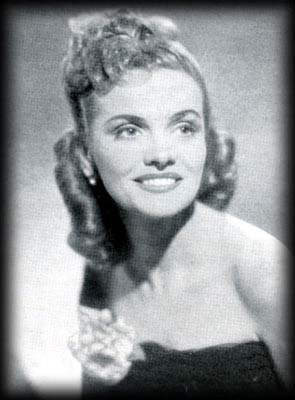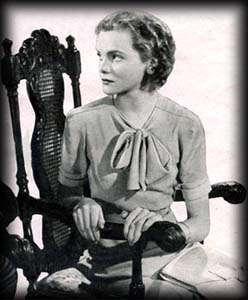|
Nova Pilbeam Biography (1942 Onwards) by Carole In a 1990 interview, Pilbeam admitted that she preferred stage work to filming and that the death of Pen Tennyson weakened her interest in working in film further. By 1942 it was obvious that her film career was not going anywhere. Her only film appearance that year was in "The Next of Kin", a training film for the armed forces about careless talk. Made to a high standard at Ealing, it was given a theatrical release despite Churchill's objections that it was demoralising. Pilbeam's role as a Dutch refugee betrayed by her supposed protector, although showy, was small and it did nothing to promote her as a film star.
|

|
|
In 1943 her only film role was for Anna Neagle and Herbert Wilcox in "Yellow
Canary". It was an attractive spy thriller for a major studio, RKO, but Nova had
only two scenes. The stage offered more interesting opportunities that year and
she spent a season with the Old Vic Company in Liverpool, playing the title role
in "Shirley", Nina in "The Seagull", the title role again in "Susannah" and the
Elders, Belle in "Ah Wilderness" and the lead in "Romeo and Juliet", Pen's favourite
Shakespeare play.
She was apparently involved in two shorts in 1944, "Out of Chaos", a Jill Craigie documentary about war artists and "Man of Science", which was about phycicist Michael Farraday. What her involvment was is unclear.
The year was dominated, however, by "This Was a Woman", which opened in March and
ran for almost a year in the West End. Nova supported Sonia Dresdel at the
Comedy Theatre in a tale of evil in suburbia.
In 1946 she had returned to the cinema with a second lead in "This Man is Mine" for Columbia. It was Glynnis Johns who got the man. 1947 saw her in "Green Fingers", which like the above has not been revived for twenty years, although I am assured that it seemed to be on television every week in the 1960s! Again a supporting role, but a showy one of a bitchy unbalanced sophisticate, Nova remembers it as a particular favourite. On March 27 1948, Picturgoer Magazine ran an article called Twelve Years After, pondering what had happened to Nova's career since her prize winning performance in "Tudor Rose". It lamented the lack of Hollywood style grooming available in the haphazard British film industry, which allowed promising careers to flounder. It was prompted by the fact that she had two new films awaiting release and the writer hoped that they would bring her back to stardom. However "The Three Wierd Sisters", a Welsh gothic tale written by Dylan Thomas and Counterblast, a post war horror of the Nazis story with Mervyn Johns, proved to be her cinematic swansong. Pilbeam was sophisticated and attractive in both, but having been made for British National Pictures, who specialised in low budget comedies, they were never going to be in the front rank of releases and her film career ground to a halt. Pilbeam continued to appear on the stage until at least 1951, including another West End appearance in February 1950 with Kathleen Harrison in "Flowers For The Living". On 27 November 1950 at Chelsea Registry Office, Nova was married again to BBC radio journalist Alexander Whyte. The honeymoon in Norfolk was followed by a theatre tour in "The Four Poster" with Barry Morse. In July 1952, the couple's daughter Sarah Jane was born and it would appear that Nova settled for the domesticity she had craved during her first marriage.
She was last known to be living in an attractive town house in Highgate (London)
with Sarah Jane, no longer interested in discussing her career. An aspiring Australian
film maker named Russell Pilbeam, is said to be her great nephew. | |
Nova Pilbeam Biography - Top Page
Previous Part of the Biography - 1937-1941
Nova Pilbeam - Top Page
Back to the Wickedlady Films Top Page
All text © Copyright 2001 wickedlady.com.
May not be reused or reproduced in any shape or form without permission of the copyright holder.
